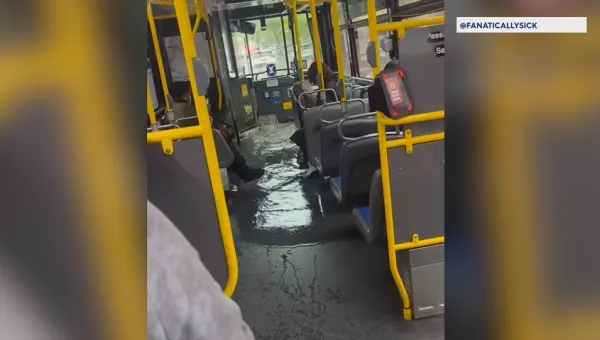Rapid building technique gets scrutiny after bridge collapse
<p>The deadly collapse of a pedestrian bridge in Florida has cast a spotlight on a rapid construction technique widely used around the U.S.</p>
News 12 Staff
•
Mar 18, 2018, 2:26 AM
•
Updated 2,229 days ago
Share:

By JASON DEAREN
Associated Press
Associated Press
As the 950-ton concrete bridge section was swung into place over a highway last weekend, Florida International University officials were beaming with pride.
The pedestrian bridge on the edge of the Miami-area campus was a signature achievement of the school's Accelerated Bridge Construction University Transportation Center, a research group set up with federal funding a few years ago to show how spans could be built faster and cheaper in the U.S.
"FIU is about building bridges and student safety. This project accomplishes our mission beautifully," FIU President Mark B. Rosenberg boasted that day. "We are filled with pride and satisfaction at seeing this engineering feat come to life and connect our campus to the surrounding community."
Five days later, the bridge collapsed onto the busy six-lane highway, crushing cars and killing at least six people in a tragedy now under federal investigation.
While it's not yet clear what caused the failure of the unfinished span Thursday, the disaster has cast a spotlight on a rapid construction technique widely used around the U.S.
Accelerated bridge construction, or ABC, involves assembling large sections of a span offsite, then moving the massive pieces into place all at once.
The technique eliminates the lengthy road closings and other traffic disruptions that can result when a bridge is built out over a highway piece by piece. It is also considered by some engineers to be safer for hardhat workers and motorists because much of the construction isn't done in the middle of traffic.
The general approach has been around since the mid-19th century - and has been used safely and successfully for a long time - but interest in ABC has increased in recent years as states have looked for quicker, less expensive ways to replace thousands of aging bridges.
In the case of the Florida tragedy, engineering experts said the question is where was the fatal mistake: in the design of the bridge, in the way its construction was carried out or in the materials used?
Civil engineering experts who viewed photos of the planned structure and the collapse have raised questions about how FIU and its contractors approached the project.
To some bridge engineers, the decision to install the span's main concrete segment over a busy road before building its main support tower was puzzling. Traditionally, the tower is constructed first, and the walkway or roadway is anchored to it with cables.
"It's odd," said Henry Petroski, a professor of civil engineering at Duke University and a leading authority on engineering failures. "That's probably why they used this so-called ABC method, so they could get the span over the roadway in one operation, because if you do it incrementally, you have to interrupt traffic."
Investigators will also be looking at the companies building the project, a collaboration between MCM Construction, a Miami-based contractor, and Figg Bridge Design, based in Tallahassee. Both companies have been involved in construction accidents before.
FIGG was fined in 2012 after a section of a bridge it was building in Virginia fell and injured several workers. Virginia's labor department later fined Figg for construction violations, and a subcontractor sued accusing the firm of negligence and poor design. MCM was accused of substandard work in a lawsuit filed this month by a worker injured when a makeshift bridge the company built at the Fort Lauderdale airport collapsed under his weight.
Professor Amjad Aref, a researcher at the University at Buffalo's department of civil, structural and environmental engineering, said it is unclear what the builders at FIU were using in lieu of a tower to support the segment that collapsed.
The span had some kind of cables to help support it, and the bridge section that collapsed was attached to two smaller pylons at either end.
But in ABC projects like the FIU span, the loss of the extra support from the main tower during construction is a risk, he said.
"Until all the pieces are put together to transmit the loads safely to the foundations, these bridges may suffer disproportionate or full collapse due to instability," Aref said. "Typically, this process requires a few weeks. During that time, they are often supported by another system to ensure stability because they are really vulnerable to collapsing."
"I am really puzzled that the tower does not exist," Aref said.
Utah started using the ABC technique in 2007 and it has since become the primary way bridges are built, with more than 200 of them around the state, said Carmen Swanwick, chief structural engineer with the state Transportation Department. She said the Miami collapse doesn't undermine her confidence in Utah's bridges, which are inspected every two years.
"I have no concerns," Swanwick said. "We believe it improves quality. A lot of times, the component or the bridge itself is constructed in a more controlled environment."
Engineers say the method has been used safely in other projects for years, and in general keeps the public safer.
"What really bothers me is with ABC, the benefits are so substantial that I would hate to see this accident lead to its reduced use," said Michael Culmo, a bridge engineer in Connecticut who has worked on accelerated construction projects for decades. "While this is a tragedy, the process itself is very safe."
___
Associated Press writer Brady McCombs contributed to this report from Salt Lake City.
___
Follow Jason Dearen on Twitter: http://www.twitter.com/JHDearen
Copyright 2018 The Associated Press. All rights reserved. This material may not be published, broadcast, rewritten or redistributed.



















